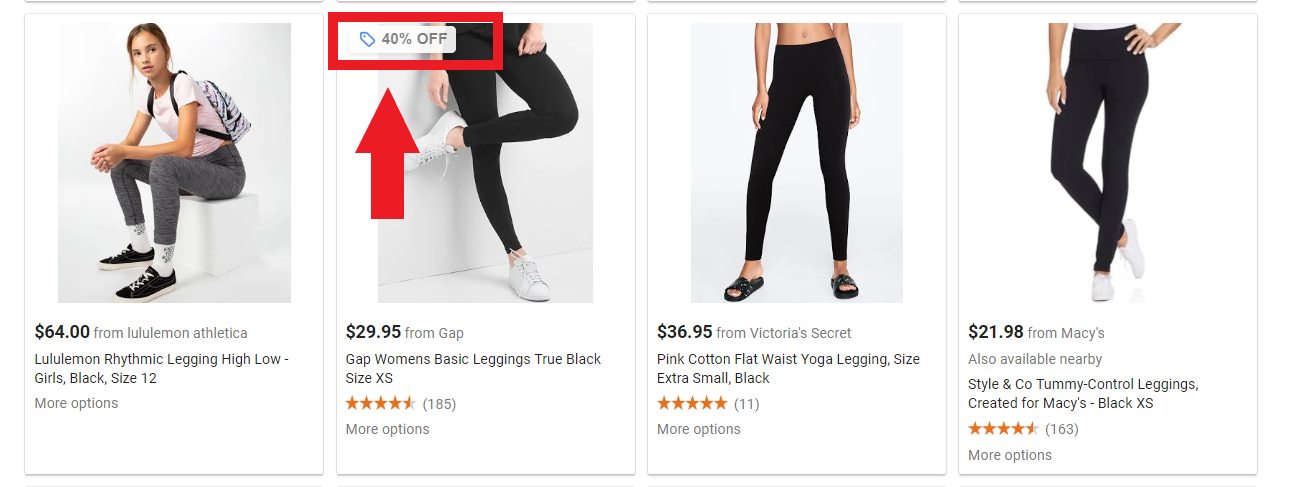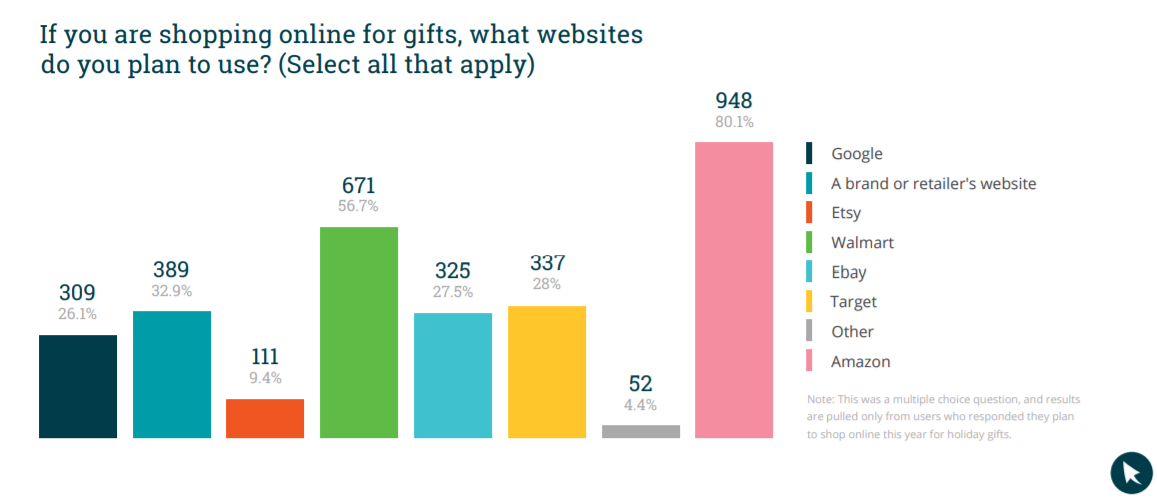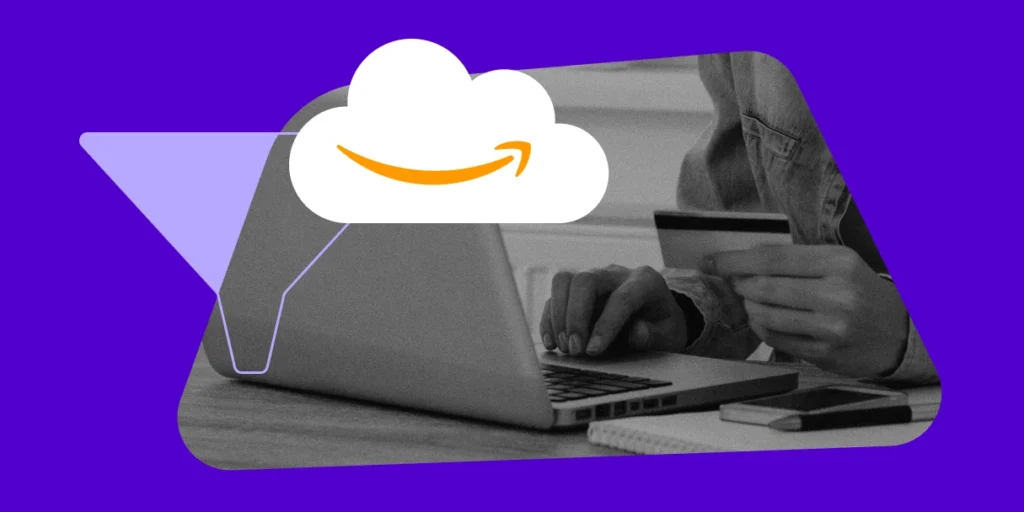With a record-breaking holiday season in Q4 2017 that saw traffic jump by 43% and revenue by 30%, a Google Shopping advertising strategy is an absolute must for ecommerce retailers that want capitalize on the upcoming shopping season.
Especially considering the surge in revenue coming from Q4 mobile shopping and Google’s mobile-friendly enhancements that capitalize on the trend, like Showcase shopping ads.
Consumers spent over $19.6 billion online during the five-day period from Thanksgiving to Cyber Monday in 2017 — a 15% YoY increase boosted by mobile shopping growth.
Here’s a list of best practices and advanced strategies for Google Shopping campaigns and Product Listing Ads that we advise our clients and readers to make full use of as we head into another record-breaking Q4 holiday season.
As consumers continue to gravitate toward mobile for product discovery and shopping decisions, leveraging a sophisticated Google Shopping strategy is a must for capitalizing on the upcoming Q4 shopping season.

-Josh Brisco, Senior Retail Search Manager & Bing Evangelist at CPC Strategy
Google Shopping Q4 Preparation: The Basics
1. Reflect & Recap Past Performance
Before you jump into a conversation about Q4 strategy, it is important to reflect on your recent Q3 campaign performance and also last year’s Q4.
This is an opportunity to review key wins at the channel, campaign & product level (as well as areas for improvement).
Ask yourself the following:
- What were my top performing categories, SKUs, and terms — both for Google Shopping and sitewide?
- Which SKUs, brands, categories, and terms saw the largest QoQ growth?
A recap of this year (and last year’s) performance should help inform your decisions to clarify and set attainable goals for Q4.
This is also a chance to outline your new initiatives and top priorities. For example, are you expanding your catalog or launching new products or brands?
Consumers start shopping earlier every year
Our survey showed that 40% of shoppers plan to buy their gifts before Thanksgiving.
Advertisers should capitalize on this extended holiday funnel by planning and executing their paid media strategy earlier rather than later.

2. Build Out Your Promotional Calendars Early
With a crowded holiday schedule, it’s important to map the promotions you plan to run on your accounts ahead of time with a promotional calendar.
A detailed promotional calendar should help organize which products are being promoted and during which days.
You may also want to use this to map out your social content calendar to coordinate these promotions across social channels as well.

Don’t forget the following holidays in your promotion schedule:
- Thanksgiving, Nov 22
- Black Friday, Nov 23
- Small Business Saturday, Nov 24
- Cyber Monday, Nov 26
- Green Monday, Dec 10
- Super Saturday, Dec 22
- Christmas, Dec 25
3. Expect Budgets & Bidding To Increase
Traffic will spike in Q4, especially in the months of November & December. In addition to traffic, average CPCs will rise as competition increases. To capitalize on increased demand, retail brands will need the budget to cover increased costs.

You’ll want to ramp up your bids on the days leading up to a major holiday so that you can capture audiences early on as they are exploring and comparison shopping, with even higher bid modifiers on the actual holidays.
“Ensure that you are inflating your bids on the bigger shopping holidays because the competition is going to increase as conversion rates go higher,” says Brisco.
- Expect clicks, spend & average CPCs to increase by 20-50% when compared with Q3.
- Increasing daily budgets prior to Black Friday & Cyber Monday and monitor closely.
- Set up a budget campaign for top performing products / categories that are guaranteed to do well.
3. Make Use of Automated Bidding
Automated bidding can also be useful when managing many campaigns at the same time, so make use of them. However, Brisco cautions that you should test your automated bidding strategies before implementing them for Q4.
“Automated bidding strategies can also be useful for Q4,” says Brisco.
“It’s best to test them out now before your promotions actually run so that you can verify they are working as intended.”
4. Optimize Your Product Feeds & Get Your Ads Approved
Make sure your product feeds are in good health before heading into the busy quarter.
This means using custom labels for SKU segmentation, uploading your promotions and marking free shipping SKUs to Merchant Center, testing different titles and descriptions for holiday-specific messaging, and filling out additional product attributes to provide as much data as possible.
Check out our post on 8 Google Shopping Product Feed Optimizations for more tips on getting your product feed Q4 ready.
Retailers should also make sure their ads are 100% approved before they turn them on.
You don’t want to go through the trouble of optimizing all your ads for Black Friday and Cyber Monday – only to find out they have been disapproved by Google the day of the sale.
According to Google, all ads, whether loaded in an active or paused state, will be reviewed within one business day. Especially during cyber week, Google will be bulking up their workforce to get these ads reviewed as quickly as possible.
Pro-Tip: The only exception to this rule is Google Shopping special offers, which is reviewed on the actual start of the promotion.
5. Ramp Down Bidding After Final Ship Dates & Back Up Again Between Christmas and New Year’s
Ramp down your bidding after your final ship date.
Unless you have an omnichannel presence where your products can be purchased in-store, you’ll want to ramp down your bidding modifiers after your final ship date.
On the day just before Christmas, for example, most people can no longer receive their shipments in time, so they are essentially browsing for what to purchase in-store. Even though volume might remain high, CVR and orders will drop off. You want to make sure to adjust your budget (& bids) accordingly. Lower your bids during this period to avoid wasted ad spend.
Make sure to scale back after your final ship date.
The Q4 shopping season doesn’t end after Christmas. There is a significant trend in traffic that takes place between Christmas day and New Year’s.
During this time, consumers search for accessories for gifts received, browse end of year sales, and spend their gift cards and holiday money online.
You can capitalize on this week of increased traffic and sales by ramping up your bids and budgets again between Christmas and New Year’s.
Google Shopping Q4 Preparation: Advanced Strategies
6. Layer in Remarketing With RLSA Campaigns
Reactivate recent visitors with RLSA (Remarketing Lists for Search Ads) for users visiting your site the week of Thanksgiving through Cyber Monday to stay front and center during the shopping holidays.
Targeting people that have previously been to your site, past purchasers, or audiences that have interacted with your business in one form or another is a powerful opportunity for driving lower funnel conversions and repeat purchases.
When potential customers leave a site, remarketing lists help retailers connect with those shoppers while they continue to search for what they need on Google.
Conversion rates are substantially higher for audiences that are familiar with your brand or have been to your site when compared to normal users. If you want to focus on the users behind the searches and not just the keywords themselves — that’s where RLSA becomes valuable.

-Nick Manessis, Lead Retail Search Manager at CPC Strategy
Make sure you have global sitewide tagging installed on your website
To make full use of data collected for your remarketing initiatives, you’ll want to ensure that you are correctly tracking all sitewide behavior and conversions with Google’s new sitewide tag.
This is especially important for gathering conversion data from Apple Safari users that can no longer be tracked due to Intelligent Tracking Prevention 2.o.
7. Use Customer Match Targeting
Advertisers can also leverage Customer Match to re-engage last year’s holiday shoppers who purchased during Q4.
Customer Match allows advertisers to upload their customer and promotional email address lists into AdWords. From these email lists, retailers can build campaigns / ads specifically designed to reach their audience.
With Google Customer Match, retailers can:
- Generate awareness with customers that are likely to be interested in a product based off of past purchases.
- Utilize valuable customer data to tailor messaging in marketing campaigns (ex: target shopping cart abandoners).
- Drive purchases through upsell or crosssell strategies.
- Leverage customer relationship management (CRM) data to promote repeat purchases and increase loyalty.
Although Google Customer Match is designed to help retailers reach their “highest-value customers” by strengthening connections with your known customer base on Google Search, it also helps retailers forge new relationships across other channels including YouTube TrueView & Gmail Native Ads.
8. Include Merchant Promotions (formerly Special Offers)
Last year, merchant promotions were a big deal for Shopping performance in Q4.
Merchant Promotions – also called special offers – give retailers an opportunity to highlight their products and better their chances of click-through rate and conversion.

Online advertisers can feature coupons or promotions right in the search alongside their product or store information on Google’s PLA grid.
Don’t wait too long to submit your Google Promotions feed.
If retailers submit a promotion too late, the feed could get rejected. At that point, retailers are forced to remap and assign a new ID. By the time the process is approved, you could run the risk of missing out on Black Friday traffic completely.
Although Black Friday and Cyber Monday are known to increase search volume – this doesn’t necessarily translate to an increase in sales for every business.
It goes back to understanding the impact that Black Friday and Cyber Monday have on certain accounts. For businesses that sell gifted items like electronics or apparel – it’s going to fly but not so much for a company that sells curtain drapes or light fixtures.

-Anthony Artuso, Retail Search Manager at CPC Strategy
The verticals that benefit most from Special Offers on Black Friday and Cyber Monday include (but are not limited to):
- Apparel
- Shoes
- Electronics
- Sporting goods
- Jewelry
- Video games / software
- Appliances
- Brand names (JCrew, Anthropologie, Levi, etc.)
9. Segment Your Shopping Campaigns Using an ISO Strategy
ISO Shopping campaigns leverage priority settings and negative keywords to isolate and allocate more aggressive bids and budget to certain high-value searches to get max impression share on top Search Terms during Q4.
This advanced strategy gives advertisers more control over which search queries their products show up for. It also allows them to isolate and dedicate budget to search queries that historically convert well.
With ISO campaigns, although we can’t target keywords directly, we can leverage negative keyword lists in an alternative campaign and then utilize the priority settings so that searches funnel into the right campaign.
You can use these keyword lists to target every part of the Google Shopping Funnel.
ISO campaigns are constantly gathering new data, so it’s important for advertisers to avoid the “set it and forget it” mentality. Shifts in the market are inevitable due to seasonality or trends – so it’s critical that advertisers keep a close pulse on which search queries are performing well for their products.
10. Leverage Showcase Shopping Ads For Increased Upper Funnel Volume
Showcase Shopping Ads can place your products in front of shoppers earlier in the customer journey by displaying for non-branded searches.
More than 40% of shopping-related searches on Google are for broad terms like “women’s athletic clothing” or “living room furniture.”

These mobile-optimized ad units enable customers to explore and discover what they want to buy by swiping through brand collections for a broad category or search term.
Advertisers that can surface their brand offering here will benefit from the greater search volumes of Q4.
“We continue to see increased volume here and search term coverage, and expect this trend to continue through Q4,” says Josh Brisco.
If retailers are not leveraging this ad format, they will be losing out on impressions for these type of searches.
11. Use Geo-targeting Modifiers
We also recommend getting more aggressive with geo-targeting modifiers for best performing areas on the days leading up to Black Friday/Cyber Week.
Geography-based bid changes or modifiers is a feature which allows advertisers to change bid percentages based on locations.
 Keep the following things in mind when setting up Geo bid modifiers for Google Shopping Campaigns:
Keep the following things in mind when setting up Geo bid modifiers for Google Shopping Campaigns:
- Decide what regions you want to target based on your site, audience and performance goals.
- Consider segmenting for online and brick and mortar locations.
- Note customer intent based on location (remember location and targeting intent can be combined)
- Utilize mobile ads for customers close to stores which can be redeemed in-store
- Delve into Analytics data, and AdWords dimensions reports (Geographic report, location report, custom columns to reflect visitor data)
- Avoid setting location to the entire US to limit click spend
- Remove unwanted locations. Exclude areas which don’t improve ROI and increase click-through.
Pro-Tip: Depending on your situation, you might want to get even more granular by drilling down to the city/zip code level if you haven’t already.
12. Use Auction Insights To Stay Ahead of Competitors in Q4
With more advertisers putting more spend into Shopping than ever before, it’s important to know exactly when impression shares begin to rise.
Our experts leverage Google’s Auction Insights to compare their performance with other advertisers who are participating in the same auctions as them. The Auction insights report is available for both Search and Shopping campaigns.
Roman Fitch, Senior Lead Retail Search Manager at CPC Strategy, says that this type of information can help retailers make strategic decisions about bidding and budgeting choices by showing specifically where they are succeeding and where they may be missing opportunities for improved performance.
These insights enable you to review when your competition started ramping up in shopping the year prior by seeing when impression share starts to jump.
Additional Q4 Prep for Google Search Text Ads
In-market Audiences
The enormous spike in shoppers exploring and comparing products on Google Shopping this quarter make In-market audiences an effective tool for targeting consumers ready to make a purchase.
Powered by machine learning that analyzes a trove of search queries and user website behaviors, In-market audiences can help you reach users that are determined to be researching or in-market for a particular product.
In-market audiences can be particularly useful if you want to hedge your bets on prospecting audiences that are likely in the process of buying something you sell.

-Adam Harms, Senior Retail Search Manager at CPC Strategy
Ad Extensions
Ad extensions are a specific type of ad format that shows additional information “extending” from your text ads about your business. These give your ad more prominence on the search results page and can be added manually and / or automated.
According to Roman Fitch, Retail Search Manager at CPC Strategy, ad extensions such as sitelinks, call outs, and structured snippets can be an effective way to feature Cyber Monday / Black Friday specials about your business.
- Sitelinks are clickable and can direct shoppers to a specific Black Friday page or a top-seller product page.
- Structured Snippets are not clickable but allow retailers to feature their styles, product types, or brands. For example, a retailer could feature “Brands: Nike, Adidas, New Balance.” Google introduced new specialized snippet extensions for the Cyber Sales, including a “Black Friday” sale snippet and one for “Cyber Monday” which retailers can leverage to highlight their offers.
- Call outs are not clickable but include attractive offers such as “Free Shipping – Black Friday Only.”
Scheduling your call outs is really important because it ensures they’ll only run at specified times and eliminates the possibility of sending conflicting messaging, not to mention it saves time.

-Roman Fitch, Senior Lead Retail Search Manager
Retailers can create custom scheduling (by the day / hour) to cater to each of the upcoming sales including Black Friday, Pre-Cyber Monday, and Cyber Monday.
Also, it’s important to remember the custom scheduling time default is set to the retailer’s time zone. Marketers should take that into consideration when setting up their custom schedules. (For example, if you are managing an account in the U.S. that is based in Australia).
Price Extensions
Price Extensions on mobile for text ads can be used to highlight your top products and promo pricing for the shopping holidays.
Google AdWords Price Extensions help advertisers:
- Create Upselling Opportunities – This isn’t just an opportunity to appeal to the thrifty—there may be some searching for better value, even if it costs a little more. For example, if someone is searching for a washing machine. An advertiser’s ad group for washing machines can show a Price Extension for three of my basic washing machines, and potentially, I could add on a bundled washer/dryer deal in one of those slots.
- Take Up Space on the SERP – There’s nothing better than dominating the top of the mobile fold. If you’re running upgraded Sitelinks with description lines, the description lines don’t always show, but for Price Extensions, you’ll get those extra 25 characters. Also, you can choose which landing page to drive the traffic to for each item. Sitelinks are the only other clickable extension, so this gives you most links on the SERP that can be clicked, and link to a deeper, more specific page on your site.
- Save Money on Unprofitable Clicks – Prices at the SERP level means your audience will be informed before they click. If your audience is price conscious and your products are on the expensive side, before Price Extensions, you may get a lot of unprofitable clicks. But if those same customers can see the price before they click on the ad, they will be less likely to click on the ad, and that will save the advertiser money.
Pro-Tip: Make sure your site is mobile optimized. According to Google, Price Extensions link to your mobile site, so it’s important to make sure your site is mobile-optimized.
Ad Copy Changes
You can highlight your holiday sales by creating a new batch of ads with updated ad copy featuring “Cyber Monday / Black Friday” or simply utilize ad extensions to highlight your sale.
An example of an ad copy change would be to include Cyber Monday in your title and/ or description such as “Nike Shoes – Cyber Monday Sale” & “20% Off This Cyber Monday Only.”
It can be risky to completely update your ad copy (especially if it’s just a one day sale) because when you change ad copy, especially headlines, you run the risk of decreasing your quality score.
It’s important to remember that ad rank (a combination of bid, ad quality, and the expected impact of extensions and other formats) is greatly impacted by quality score changes.
If you change your headline, you might lose a little bit of your quality score and could be fighting an uphill battle from the beginning of that day – trying to get your quality score back up.

-Lewis Brannon, Senior Manager, Retail Search at CPC Strategy
The silver lining is even if retailers lose some ad authority at the beginning of the day – they can still close out the day with good volume.
If retailers have access to a quality score tracker (a custom, javascript-based technology) – they should be able to track their quality score through Black Friday and Cyber Monday.
Unfortunately, when it comes to the ad copy vs. ad extensions debate, there isn’t a one size fits all type of answer, but this is definitely something retailers and marketers should be aware of.
If you do decide to go ahead and update your ad copy- we recommend monitoring your quality score closely so you can be better informed when making this decision next year.
“In my opinion, I would probably stay away from changing the ad copy headline because the headline has the most impact on quality score. Unless you’re average position is really low and your site links don’t normally show – then I would probably default to using fresh ad copy to make sure your message gets some visibility,” Brannon said.
“But, if you are brand with a solidified quality score and high ad rank, you might want to rely solely on ad extensions to highlight your offers, and avoid sacrificing quality score / ad rank on your top performing ads.”
Don’t Forget About Amazon
No matter how effective your Shopping strategy is, a good portion of your shoppers will complete their journey elsewhere — such as your ecommerce website or Amazon store.
Q4 Bidding Optimization Best Practices Checklist
- Traffic will spike in Q4, especially in November & December.
- In addition to traffic, average CPCs will spike as competition increases.
- To capitalize on increased demand, you need to increase your budgets to cover increased costs.
- Expect clicks, spend & average CPC’s to increase 20-50%+ vs. Q3.
- Higher frequency – make bid adjustments daily/multiple times a day.
- Review search terms more frequently. Do live Google searches to ensure you’re still showing for your top terms. Add negatives for irrelevant terms.
- Review ad scheduling. Shoppers are often doing their searches late nights and early mornings during cyber week.
- Increase daily budgets & monitor closely. Unless working with a strict budget, play it safe and increase aggressively.
- Increase budgets again prior to Black Friday / Cyber Monday.
- Ramp down your bids after final shipping dates to avoid wasting ad spend.
You Might Be Interested In



















